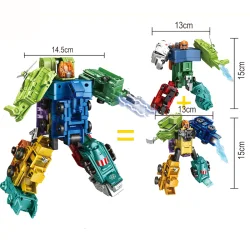Here are some types of robot and tech toys
2024-01-09
Robot and tech toys are interactive playthings that incorporate technology, robotics, and various electronic components to engage and entertain users. These toys often encourage learning, creativity, and problem-solving skills. Here are some types of robot and tech toys:
1. Robotic Kits:
- Robotic kits come with components that users can assemble to build their own robots. These kits often include motors, sensors, and programmable controllers, allowing kids and enthusiasts to learn about robotics and coding.
2. Coding Robots:
- Coding robots are designed to introduce children to programming concepts. These robots can be programmed using simple visual coding languages or apps, helping kids develop computational thinking and problem-solving skills.
3. Educational Tablets:
- Educational tablets are interactive devices designed for children, featuring age-appropriate educational games, videos, and apps. They can cover a variety of subjects, including math, language arts, and science.
4. Augmented Reality (AR) Toys:
- AR toys use augmented reality technology to enhance the physical play experience. These toys combine physical objects with digital elements, providing an interactive and immersive play environment.
5. Drones:
- Drones, or quadcopters, are remote-controlled flying devices equipped with cameras or sensors. They can be used for recreational flying or educational purposes, teaching kids about aerodynamics and basic principles of flight.
6. Electronic Building Blocks:
- Electronic building blocks allow children to create their own electronic circuits without soldering. These kits typically include modular components that snap together, enabling kids to experiment with basic electronics.
7. Smart Toys:
- Smart toys are connected to the internet and can interact with users through voice recognition, sensors, and other technologies. Some examples include interactive dolls, plush toys, or action figures that respond to commands.
8. Robot Pets:
- Robot pets mimic the behavior of real animals and provide companionship. They can respond to touch, follow commands, and exhibit lifelike movements without the responsibilities associated with real pets.
9. 3D Printers for Kids:
- Simplified 3D printers designed for children allow them to create their own toys and objects by designing and printing them layer by layer. These devices promote creativity and an understanding of 3D printing technology.
10. Virtual Reality (VR) Headsets:
- VR headsets provide immersive experiences by transporting users to virtual worlds. Some VR systems are designed specifically for kids, offering educational content or games that leverage virtual reality technology.
11. Interactive Storytelling Devices:
- Interactive storytelling devices combine traditional storytelling with technology. They may include devices that read aloud, respond to questions, or allow children to make choices that affect the narrative.
12. STEM Learning Toys:
- STEM (Science, Technology, Engineering, and Mathematics) toys focus on educational play that enhances skills in these areas. They often involve building, experimenting, and problem-solving.
13. AR Drawing and Coloring Kits:
- AR drawing and coloring kits combine traditional art activities with augmented reality technology. Children can draw or color on paper, and the app or device brings their creations to life on a screen.
Robot and tech toys contribute to a dynamic and educational play experience, fostering curiosity and a passion for technology. When selecting these toys, parents and caregivers should consider the age appropriateness, educational value, and safety features to ensure a positive and enriching playtime for children.



